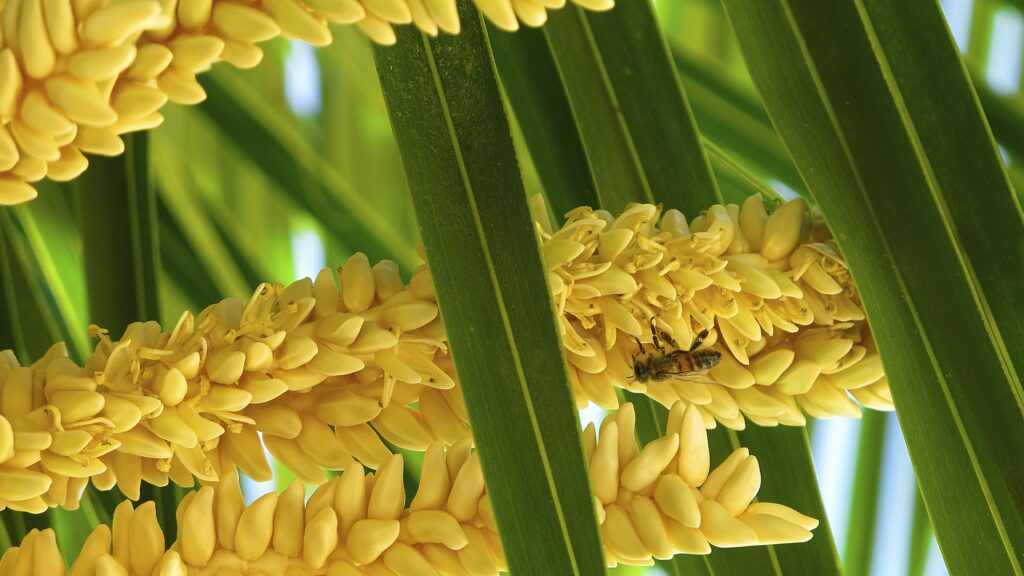The mystery of how the lofty palm trees in tropical and subtropical regions reproduce keeps fascinating botanists and palm enthusiasts. With over 2,500 different palm tree species worldwide and millions of years of reproduction, it’s surprising that researchers still find new evidence that runs counter to conventional thinking.
There is no single way in which palm trees reproduce. The mystery of their reproduction even is paradoxical to conventional thinking of pollination and seed dispersal. Some palm trees flower and bear fruits underground. Others depend on weevils, insects, and wildlife to reproduce.
Dispersal and wind pollination is a part of the lifecycle of palms. But other puzzling scientific findings involve underground fruits and seeds at the base of palm trees. Researchers also look at the relationship between palm flowers and seeds and their pollinators. So, how do these trees reproduce?
How Do Palm Trees Reproduce?

Palm trees belong to the Arecaceae group of trees, which is an offspring of the earliest monocot family of trees. The monocots date back to the late Cretaceous period, which has been documented as 80 million years ago. Today, palms grow in regions as diverse as rainforests and deserts.
Although diverse as a tree species, palm trees reproduce through palm seeds. The palms’ evolution has distinctive intra-familial traits. But that doesn’t mean that the reproduction of palm trees is the same. Researchers are constantly looking at different ways in which the trees reproduce, how they pollinate and which dispersal strategies happen in nature.
What one has to take into account is that palm species take between three and forty years to flower for the first time. There are many variables, too, as the flowering period depends on the species, and palms also have separate male and female flowers. Researchers have found that not all palms bear their flowers and fruits above ground either.
There’s more to palm trees’ reproduction than what meets the eye at first glance. The tree species owes its existence to the following:
- Pollen
- Seeds
- The role of bees, beetles, insects, and mammals
- Wind dispersal
Current thinking about palms’ reproduction contrasts with earlier wind dispersal and pollination theories. In addition, in the last three decades, palm tree specialists and scientists have realized that these ancient trees are pretty enigmatic in their reproduction. Many mysteries leave the field open to investigation.
Recent Studies on How Palms Reproduce
In the last three decades of fieldwork in remote forests, scientific discoveries have included underground flowers and seeds in particular palms and specific areas of the world. The mystery of these flowers and seeds a few inches below the earth’s surface opens up new research directions on how palm trees reproduce.
Not only is the discovery of underground flowers, fruits, and seeds new to researchers looking at how palms reproduce. There are also studies on weevils’ role in palm forests as crucial pollinators. This is, besides other insects, even mammals’ role in the reproduction of palms.
The earliest research shows how beetles (cantharophily), bees (mellitophily), and flies (myophily) aid palm reproduction – a pollination process with insects transferring pollen from anthers to the flowering palm’s stigma.
The discovery of underground flowers and seeds and the role of weevils as pollinators have researchers eager to explore more.
Palm Trees Paradoxical Reproduction
When researchers found the underground flowers and seeds of Borneo’s rainforest Pinanga subterranea (Arecaceae family), they were amazed and called it ‘paradoxical reproduction.’ The palms’ subterranean flowers and fruit were a finding contrary to thoughts of how palms reproduce through wind dispersal.
The discovery was immediately new to the scientific world primarily as the ‘subterranean infructescence’ (the underground flowering and seeds) prompts questions on how reproduction happens. Scientists are interested in how the flowers get pollinated underground and the kinds of seed dispersal strategies at play.
Scientists are also amazed that the recent findings have taken this long to uncover. These are just some of the secrets still to be revealed.
Mysteries of the Pinanga Subterranea
During their fieldwork, Veteran Kew palm researcher John Dransfield and Malaysian botanist Paul Chai needed clarification about why the Pinanga subterranea produced flowers and fruits a few inches underground.
Some deductions they made were that fruiting and flowering underground protected these from surface predators. But what perplexed them was how the pollen and seeds were dispersed from the underground. Besides insects living underground, the mechanism of pollination remains a mystery to them.
Interestingly, they saw wild boars feasting on the red fruit of the Pinanga subterranea. And found that the seeds of Pinanga subterranea that had been excreted germinated in the wild boars’ dung.
Researchers also found that the underground fruits of the Pinanga subterranea were a familiar food source to indigenous people. This meant scientists could learn about palm trees from these indigenous knowledge systems.
Pollinators and their Mystery Ways
Just as there are mysteries still to be solved by researchers working on reproduction in underground fruits and seeds of the Pinanga subterranean, so too, for Brazilian biologist Bruno de Medeiros, there are ‘mysterious trade-offs’ between plants and their pollinators. Bruno looks beyond the classic notion that palms are pollinated by wind.
Recent field studies in remote palm forests show that palm trees’ reproduction could be more complex. Many mysteries and secrets await botanists and palm enthusiasts, like:
- The Pinanga subterranea’s underground flowers and fruits (and seeds).
- The palms’ reproduction.
- The secret lives of pollinators.
Completing a Postdoctoral Fellowship at the Smithsonian Tropical Research Institute (STRI), De Medeiros’ interest in pollination biology pushed him to think about insects and their relationship to tropical forests. His findings are based on the idea that plants, especially those of the tropics, have a symbiosis with the insect life there.
The uniqueness of the insects is specific to the tropical forests they inhabit. The insects and their relationship to the woods comprise a diverse ecosystem, including the mysterious ways palm trees reproduce.
What stands out from Bruno’s research is that the weevils in Brazil and Panama’s palm forests are pollinators and scavengers. The weevils pollinate the flowers and also eat the seeds of the palm tree fruits.
The weevils, other insects, and even mammals’ survivalist needs are part of the world’s palm forest ecology. So, too, are the indigenous knowledge systems of locals. The latter is evident in how locals were eating the bright red fruit of the underground infructescence of the Pinanga subterranean long before the recent scientific discovery.
Final Thoughts
While unveiling the secrets of palm tree reproduction, scientists have studied the trees, their flowering and fruit-bearing, and their pollinators. From beetles, bees, and flies to bats and marsupials, the processes happen under the tropical and subtropical forest canopies and even underground.
The mystery of palm trees’ reproduction rests on intricate eco-pollination, tens of thousands of insects, and wind-pollination from male to female flowers. Some pollinators, like weevils, also depend on a specific palm species to complete their life cycle.

